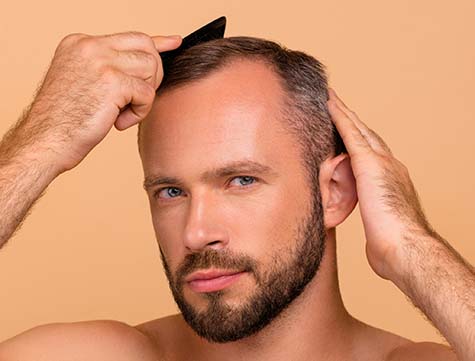Why Hair Loss Happens — and How It Differs
Hair loss, or alopecia, is a health condition where the hair-growth cycle is interrupted, which can ultimately lead to baldness. Some people experience invisible hair loss, while others suffer significant hair loss over time. At Charles Medical Group, we provide hair loss treatments for patients experiencing different types of hair loss in Palm Beach County.
Types of Hair Loss
Hair experts have identified several types of hair loss:
Alopecia Areata
This type of hair loss is due to the immune system attacking healthy tissues in the body, including hair follicles. Patients with this condition range from children to adults. Hair loss symptoms will also occur in the eyebrows and eyelashes.
Androgenetic Alopecia
This type of hair loss is commonly known as pattern hair loss. Male pattern hair loss can start after puberty as hair loss symptoms occur at the temples. The hairline will slowly recede towards the top of the scalp, resulting in baldness.
Meanwhile, female pattern hair loss is usually the effect of aging, although some women start experiencing signs after puberty. Unlike men, women will not experience their hairline receding to the top of the scalp. Instead, their hair will start thinning over time.

Cicatricial Alopecia
Also referred to as scarring alopecia, this condition occurs when inflammation results in the destruction of hair follicles, leaving behind scar tissue. Hair will no longer grow in the areas with scar tissue. There are many types of cicatricial alopecia, including frontal fibrosing alopecia and folliculitis keloidalis.
Anagen Effluvium
This type of hair loss is common for patients receiving medical treatment. Cancer patients who are receiving chemotherapy often experience this condition. Anagen effluvium results in hair loss during the anagen, or growth, phase of the hair-growth cycle. It can affect hair follicles all over the body.
Telogen Effluvium
This is a condition in which excessive hair loss occurs during the resting, or telogen, phase of the hair-growth cycle. It can affect up to half of the hairs on a person’s scalp.
Tinea Capitis
This is due to a fungal infection in the scalp, and because of this, it is also known as scalp ringworm. This type of hair loss is common to children. Bald spots may occur, usually in a circular pattern. The scalp is usually itchy and may develop sores or blisters.
Hair Shaft Abnormalities
Instead of resulting from issues with the hair follicles, this hair loss is due to thinning and breakage within the hair shaft. The hair strands are usually brittle, and this can cause overall hair thinning. There are several types of hair shaft abnormalities, including monilethrix and trichonodosis.
Hypotrichosis
This is a genetic condition that starts from birth. The hair loss symptoms will start after several months, and shed hair will only be replaced with sparse hair. Generally, patients with this condition will experience total baldness around 25 years old.




